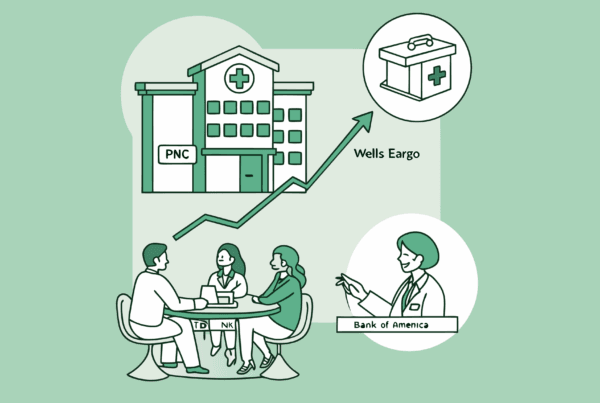This guide provides a clear path for practice owners in Cincinnati who are considering a sale. We cover market trends, valuation, and the steps needed for a successful transition.
The market for Hospice and Geriatric care is expanding rapidly, creating a significant opportunity for practice owners in the Cincinnati area. Selling your practice in this climate is not just a transaction. It is a strategic move that can secure your financial future and legacy. This guide offers insights into navigating the process, from understanding the strong growth in Ohio to preparing for a successful sale. Proper strategic planning is the key to maximizing your outcome.
Market Overview
If you are a Hospice & Geriatric practice owner in Cincinnati, you are operating in a strong and growing market. The timing for considering a sale is favorable, supported by positive trends at every level.
National Demand
The demand for hospice and palliative care is rising across the country. The U.S. hospice market is on track to reach nearly $65 billion by 2030. This national growth fuels buyer and investor interest, making established practices like yours an attractive asset.
Ohio’s Favorable Climate
This growth isn’t just a national story. The home care industry right here in Ohio is also expanding. This regional strength provides a stable foundation for local practices, signaling a healthy and sustainable environment for buyers looking to invest in the state.
The Cincinnati Landscape
In Cincinnati, the demand is clear. Major local healthcare systems like TriHealth and The Christ Hospital have significant geriatric and senior care services. This proves a robust local need. Well-run, independent practices are valuable in this ecosystem, either as partners or as acquisition targets.
Key Considerations
Understanding the Cincinnati market is the first step. The next is to look inward and prepare your practice for the scrutiny of sophisticated buyers. Beyond clean financials, buyers in the hospice and geriatric space focus on specific operational and regulatory strengths. A clear story around your practice’s quality of care, patient sources, and compliance is what separates an average offer from a premium one. Answering these questions now is the foundation of a successful sale.
Buyers will want to know:
1. Your Care Setting Mix: Can you provide care in various settings? A practice that serves patients in their own homes, nursing homes, and assisted living facilities is more versatile and valuable.
2. Your Regulatory Standing: Are you fully compliant with Ohio’s specific regulations, like OAC chapters 3701-19 and 5160-56-01? Demonstrating clean, current licensing with the Ohio Department of Health is non-negotiable.
3. Your Palliative Care Integration: Do you offer comprehensive palliative care in addition to hospice? Integrated services are a major focus for buyers and can set your practice apart.
Market Activity
The Cincinnati hospice market is not just growing; it’s attracting serious investment. While national valuation multiples for hospice have been high, local activity provides the clearest signal. In 2020, Cincinnati-based Queen City Hospice was acquired for $192 million. This landmark deal demonstrates the significant value that buyers see in well-run practices in our region. While every practice is valued on its own merits, this transaction proves that the interest from large-scale buyers is strong. Your practice’s value will depend on a specific set of factors that buyers prioritize.
| Factors That Increase Valuation | Factors That Can Limit Valuation |
|---|---|
| Diverse and stable referral sources | High dependence on a single owner |
| Strong operational efficiency | Inconsistent financial records |
| Positive patient satisfaction scores | Unresolved compliance issues |
| Low staff turnover rates | Limited service offerings |
The Sale Process
Selling your practice is a multi-stage journey that requires careful navigation. Many owners think about selling only when they are ready to exit, but the most successful transitions begin years in advance. Understanding the path ahead helps you prepare properly and avoid common pitfalls, especially during due diligence when buyers dig into every detail of your operations.
1. Preparation and Valuation
This is the foundational step. We help owners analyze their finances, normalize their earnings, and gather all necessary documentation. A comprehensive valuation is performed to establish a credible asking price based on data, not guesswork.
2. Confidential Marketing
Your practice is not put on a public listing. A professional process involves identifying and confidentially approaching a curated list of qualified strategic buyers and investors who are the best fit for your practice, staff, and legacy.
3. Negotiation and Due Diligence
Once interest is established, we manage negotiations to secure the best terms. This is followed by due diligence, an intense review period. Proper preparation is key to ensuring this stage proceeds smoothly, without any negative surprises.
4. Closing and Transition
The final stage involves legal documentation, closing the transaction, and planning for a smooth handover. Our goal is to ensure your legacy is protected and your team is set up for continued success with the new owner.
How Your Practice Is Valued
Determining the value of your hospice practice is more than a simple formula. Buyers don’t just look at your revenue. They look at your profitability. The key metric is Adjusted EBITDA (Earnings Before Interest, Taxes, Depreciation, and Amortization). This figure represents your practice’s true cash flow by adding back owner-specific or one-time expenses to your net income. This Adjusted EBITDA is then multiplied by a number, called a valuation multiple, to determine your practice’s enterprise value. That multiple isn’t random. It’s influenced by your scale, the stability of your referral sources, your staff structure, and your growth potential. A practice that is not dependent on a single owner will command a higher multiple than one that is.
Post-Sale Considerations
The day your practice sale closes is not the end of the journey. A successful transition is defined by what comes next, and planning for it is a critical part of the deal structure. Thinking about these factors early in the process ensures your personal and financial goals are met long after the papers are signed.
Your Role After Closing
Most buyers will want you to stay on for a transition period, typically one to three years. This ensures continuity of care for patients and a smooth handover of relationships. Your role can be structured in many ways, and negotiating this part of the deal is just as important as the price.
Tax-Efficient Structures
The final price is one thing; what you keep after taxes is another. The structure of your sale has major tax implications. We work with owners to plan for the most tax-efficient outcomes, ensuring you protect the proceeds you worked so hard to earn.
Preserving Your Legacy
For many owners, the sale is also about protecting their team and the culture they built. Deal structures can include an “equity rollover,” where you retain a minority stake in the new company. This allows you to benefit from future growth and maintain a connection to your life’s work.
Frequently Asked Questions
What is the current market outlook for selling a Hospice & Geriatric practice in Cincinnati, OH?
The Cincinnati market for Hospice and Geriatric care is strong and growing, fueled by national and local demand. Major healthcare systems in Cincinnati demonstrate robust local need, making well-run independent practices attractive to buyers.
What are the key factors buyers consider when valuing Hospice and Geriatric practices in Cincinnati?
Buyers focus on operational efficiency, diverse and stable referral sources, positive patient satisfaction scores, low staff turnover, regulatory compliance, care setting versatility, and integration of palliative care services. These factors distinguish premium offers from average ones.
What is the typical process for selling a Hospice & Geriatric practice in Cincinnati?
The sale process includes four stages: (1) Preparation and Valuation involving financial analysis and documentation; (2) Confidential Marketing to targeted investors; (3) Negotiation and Due Diligence for finalizing terms and detailed review; and (4) Closing and Transition to complete legal formalities and ensure smooth handover.
How is the value of a Hospice & Geriatric practice determined in Cincinnati?
Value is primarily based on Adjusted EBITDA, which reflects the practice’s true cash flow by adjusting net income. This figure is multiplied by a valuation multiple influenced by factors like practice scale, referral stability, staff structure, and growth potential. Practices not dependent on a single owner often command higher multiples.
What post-sale considerations should owners keep in mind after selling their Hospice or Geriatric practice?
Owners often stay on during a transition period to maintain care continuity, negotiate tax-efficient sale structures to maximize proceeds, and consider deal features like equity rollovers to preserve legacy and benefit from future growth of the practice.



